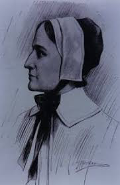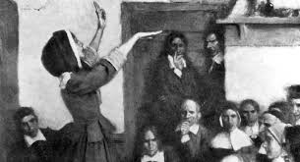Anne Hutchinson: Outspoken Religious Separatist
Anne Hutchinson was a well-known supporter of religious liberty and the rights of women in colonial America. 
Hutchinson was baptized on July 20, 1591, so she was probably born a few days before that. She was born in Alford, Lincolnshire, England. She came into the world a few years after her father, Francis Marbury, had been in jail, serving time for speaking out against the church. Marbury was an Anglican cleric who had come to believe more in Puritanism, a breakaway sect of Protestantism whose members included the Pilgrims. Marbury's trial was public; and while he was under house arrest, he wrote down from memory a transcript of what had been said at his trial. He later urged his children to read it as a form of amusement. Marbury eventually had 18 children, from two marriages, and urged all of his children, the boys and the girls, to learn as much as they could about the world around them and, of course, about the Church. He also urged them to question things. The practice of educating girls and of advocating learners to question things were at odds with common teachings in those times. Anne lived in Alford until she was 15 and became a very learned girl. The family moved to London in 1605 so her father could take a position as a vicar there. He died suddenly in 1611. Two years later, Anne married William Hutchinson, a fabric merchant whom she had known since childhood. They moved back to their hometown. Once again in Alford, they became attached to John Cotton, a minister in the port city of Boston, not far from Alton. Cotton was a Puritan preacher who was particularly taken with the idea of salvation in and of itself, not as a result of works done in the name of faith. This was an idea that flew in the face of Puritanism, which held almost the exact opposite ideal: that a good Puritan Christian was one who led a good life and did good things in the name of God. When Charles I ascended the throne in 1625, he ordered persecutions of those who didn't belong to or believe in the Church of England. This resulted in a large-scale migration of Puritans out of England. Among those who left in 1630 was John Winthrop, who would one day be governor of the Massachusetts Bay Colony. Another was Cotton, who fled to North America in 1633. Hutchinson, her husband, and their 10 children followed him a year later. (They eventually had 15 children in all.) William Hutchinson became a magistrate in Boston, and Anne found work as a midwife; they also had a 600-acre farm. They both joined the worship circle of Cotton. Anne began having prayer meetings in her home; within two years, these took place twice weekly and were attended by up to 80 people, including then-colonial governor Henry Vane. One of her beliefs was that anyone could read the Bible and interpret its teachings for himself or herself. 
Among the things that Anne Hutchinson taught were that everyone had his or her own personal connection to God and didn't need anyone else–namely priests or vicars or rectors or ministers or any other religious leaders–to help in their quest for God's grace. She also taught that the actions that a person during his or her life had not bearing on whether they went to heaven when they died. This was in direct contradiction to the teachings of the Puritan faith, which stressed an avoidance of sin because it was thought to prevent admittance to heaven; as well, the Puritan leaders didn't appreciate having Anne or anyone else question their role in the church or in the wider society. One other irritant to Puritan authorities was the she, a woman, dared to teach men–for among those dozens who regularly attended her prayer meetings were both women and men–men in religious matters. In 1637, Hutchinson was warned to cease and desist what the Puritan leaders said were heretical teachings; she refused. When she was called to a meeting with church leaders to explain herself, she refused to recant her teachings, refused to live by the directions set out by Puritan leaders, and said that she was following her own path in life because she had a direct connection to God. For all of those things, but especially for the last one, she was banished from the Massachusetts Bay Colony. She was allowed to stay through the winter, under house arrest. In March 1638, she and her family joined Roger Williams in the colony of Rhode Island. In a testimony to just how influential Hutchinson had become, 30 families went with her. They founded the settlement of Portsmouth. Williams had founded Rhode Island on the premise of religious liberty for all, and Hutchinson found herself and her teachings welcome there. They stayed there for four years, until Anne's husband, William, died, in 1642. Word of his death made its way to Massachusetts, and representatives of the authorities there paid a visit to Anne, warning her that would again be targeted by Puritan officials because the Massachusetts Bay Colony would soon be taking over Rhode Island. She believed this threat to be true and moved her family to the Dutch colony of New Netherland. It was there, on a summer afternoon in 1643, that she died, the victim of attack by neighboring hostile Siwanoy Native Americans. Only of her children, Susan, survived; she was taken prisoner by the Siwanoy warriors and lived with them for nine years before escaping. |
|
Social Studies for Kids
copyright 2002–2025
David White




